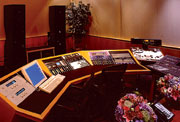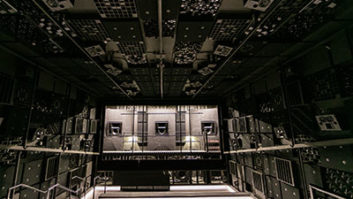
Vlado Mellor joined CBS Records more than 30 years ago, with multi-platinum credits for Celine Dion, Julio Iglesias and the Red Hot Chili Peppers. At Sony, Mellor works on a Neve digital transfer board with Neve and Prism parametric EQ while his mixes are heard through PMC monitors and subwoofers.
It’s hard to hide when you’re a music industry giant, but Sony Mastering has done a great job of just that for at least a decade. As with the other divisions of Sony Music Studios residing on Manhattan’s West Side, there’s been precious little public information about one of New York City’s most highly advanced facilities, where the rooms are labeled from Studio A to Studio Z and keep on going from there.
But Sony is lifting the veil that surrounded its audio powerhouse for so long and is giving Mix an exclusive first look at the people, philosophies and technology that make up Sony Mastering. When you consider the collection of brains, ears and gear that make this place hum, it’s a look well worth taking.

Sixteen-year Sony vet, Vic Anesini (Aerosmith, Bob Dylan, OutKast, Johnny Cash) works on a GML/Sony analog transfer console. His room also hosts numerous pieces of outboard gear and Dunlavy and Sherwood amps.
Occupying an entire floor of Sony’s complex, Sony Mastering is a heavyweight of a mastering facility. Featuring six distinctive suites and intense networking that connects them to four of Sony’s mix studios for two-way transfer of audio via analog, digital and Ethernet runs, the rooms are set up to be an integral component throughout the production process — not just the final stop. The result is an uncommonly fluid music production atmosphere that keeps mixing and mastering as closely linked as possible, whether the format is DSD, 5.1 or just plain stereo.
The fluid workflow springs from the senior mastering engineers themselves: Vic Anesini, James Cruz, Vlado Mellor, Joe Palmaccio, Darcy Proper and Mark Wilder. Along with resident audio expert David Smith, VP of Sony Music Engineering, they form a highly familial staff, as evidenced in a roundtable discussion that the busy group gathered for.

Lacquer cutting expert who came to Sony from The Hit Factory Mastering, James Cruz (Wu Tang Clan, Juvenile, Montell Jordan) works on a Prism DREAM, with Lavery Engineering D/A, Z-Systems EQ and a Neumann lathe.
Palmaccio kicked off the conversation. “Mastering is paralleling the music business in that it’s a challenging time right now,” he points out. “You have the same hurdles: Budgets are smaller, there are fewer releases now than 10 years ago, and because of the technology, there’s more people doing it with more mastering studios. So it’s always a challenge to differentiate yourself. One thing that’s different about this group is the years of experience here. This is an amazingly talented and diverse group of people, and it’s not just that we have experience, but we have varied experience.”
“I think the concept of a major label — sponsored project is going the way of the dinosaur,” Proper says bluntly. “It’s people putting out small releases, and the people putting the projects together aren’t aware of the needs for mastering. They’re creating things in their home studios and they don’t know there’s an additional layer of polishing that needs to be done.”

Former editor/engineer at Sony Classical Productions and 5.1 mastering engineer (Porcupine Tree’s In Absentia, Stelly Dan’s ,i>Everything Must Go DVD-As), Darcy Proper’s room includes custom Sony Music Engineering/George Massenburg console, Dunlavy SC-IV loudspeakers powered by Krell amplifiers and numerous outboard gear.
“These are rooms for someone with 25 or 30 years’ worth of listening experience,” Anesini explains. “With the amplifiers and speakers that are here, that’s my home away from home. It’s not like a mix engineer who will go from New York to L.A. and room to room. We don’t have that variable. I know what it’s supposed to sound like.”
The most senior member of the group, Mellor, agreed that re-education is necessary for the mastering industry to continue to grow. “There’s a whole new generation of engineers who grew up on PlayStations and workstations,” he says. “They now understand it’s a very important process — they can finalize everything on their DAWs — but they come to a mastering room and they’re totally blown away by what can be done. Producers know what mastering is, but there’s a whole new generation coming in who think they can do everything with their plug-ins.”
The Sony plant is the opposite mindset. With the mastering facility built at virtually the same time as the other 55 rooms at Sony Music Studios, there is an extreme amount of connectivity, allowing many of the engineers to see and talk to each other. The result is a highly flexible mastering system that can be individually tailored from engineer to engineer and project to project.

Three-time Grammy winner—who has mastered LPs for James Brown, Hank Williams and Pariament Funkadelic and SACDs for Norah Jones and Miles Davis—Mark Wilder relies on an SPL-proprietary console. Other gear of note includes Mastering Lab tube line amps, ATR-102 2-rack with tube option and Duntech Princess monitors with Spectral amplification.
“Every one of our rooms is unique in that it’s set up for the individuals who work there,” Palmaccio notes. “When I dream up something and I need a different workflow or system, I can make it happen with the resources of this facility. We have custom consoles, proprietary clocking systems, power conditioning — all of these things that go into what makes systems. It’s not just having a Weiss EQ or whatever; it doesn’t work like that.”
According to Wilder, the maximum networking approach is paying off. “I have a client who loves the concept of mixing and mastering simultaneously,” he confirms. “He really enjoys sitting in a room he’s familiar with with someone that he trusts — me. We’ll take a mix and I’ll start playing with it trying to get the right sound. At that point, maybe I’ll say, ‘We need to bring the horns up,’ or, ‘The drums need to be re-EQ’d.’ Then we get the mix room on the phone and tell them what we want. This way, we can bring the mix and master along simultaneously. There’s much less of my signature with EQ and compression, but a lot more of my signature in the mix.”
Although each member of the team can handle virtually any job in the facility, each also has different approaches. “Everyone here has their own style,” Cruz observes. “They go through different ways to get the final result, but there aren’t seven different islands here — there’s one big island and we’re all sharing. We all compare notes on what’s going on. I do a lot of lacquer cutting for records, while Vic does a lot of EQ’ing for lacquers that need to be cut. We talk about what EQs work best for that because they don’t all translate well, and we’ll make EQ fixes on the vinyl cutting.”

Album remastering guru (Grammys for The CompleteHank Williams and Martin Scorsese Presents the Blues, as well as surround work for Alicia Keys, Luther Vandross, G3 and Chevelle) Joseph M. Palmaccio’s suite is outfitted with a David Smith custom analog board, numerous pieces of both analog and digital processing, a Sequoia DAW, an Ampex ATR-102 and Dunlavy speakers with Classe amps.
“What makes this group special,” says Palmaccio, “is that they’ve set up an environment where this is a non-competitive group. We really care for each other and [our] careers, and we share information. I’ll say to someone else here, ‘I want to try this procedure,’ and I become aware of the pitfalls. This place allows us the latitude to do that, and that’s the reason we can go from gospel to hip hop or metal to classical.”
Whether you’re talking about sharing files, mixes or wisdom, Sony Mastering has taken advantage of its deep resources to create an extremely powerful mastering environment. For the people who occupy the suites, it’s a unique opportunity to work with music in a way that’s academic and aesthetic at the same time. “We hold an envious position,” Wilder concludes. “It’s six or seven rooms here, whereas most facilities are one room, so who do they share with? There’s a collective vocabulary here that everyone shares and it’s beautiful.”
David Weiss is Mix’s New York editor.



